 NDB are low power beacons in the 250 to 550 KHz range. The beacons are usually situated at a landing strip/airfield / oil platform to aid navigation. They are non-directional so use a vertical omnidirectional antenna, and reasonably low power. The ERP is very low, as the physical size of the antenna restricts the efficiency and the desired range is usually not more than a few tens of miles.
NDB are low power beacons in the 250 to 550 KHz range. The beacons are usually situated at a landing strip/airfield / oil platform to aid navigation. They are non-directional so use a vertical omnidirectional antenna, and reasonably low power. The ERP is very low, as the physical size of the antenna restricts the efficiency and the desired range is usually not more than a few tens of miles.
Photo credit Original uploader (and claimed/alleged photographer) was Mintaka10.
The beacons transmit in double sideband AM, so you can often see the carrier AM frequency and then on both the upper and lower side of the carrier the CW ident. The CW consists of one, two or three letters, and the morse ident is unique so can be used to geolocate the beacon.
Wikipedia contains further information on how these are used by pilots to navigate, although most shortwave listeners are simply interested in identifying the signals and working out their location. The frequencies used to lend itself to some considerable distances at night, although its often the noise floor of the local area in this bands that limits the receiver. I found my doublet antenna was poor to useless at these frequencies, and it was the Wellbrook Loop that provided a significant improvement on this and other LF, MW bands. George M1GEO has also provided some details of a homebrew version of the loop, and details can be found on his site.
If you don’t have a suitable HF receiver and aerial a good way to start is by utilising one of the online SDR receivers. Some have a text above the receiver window showing the name/location of any beacons received. You can often click on this text and the receiver will set the correct frequency and mode.
Keep in mind that local conditions and time of day will as it does on other HF bands influence the stations that can be received at any time.
 The expanded version shows just one NDB, located at Epsom and using the CW ident EPM. The AM carrier can be seen in the center, with the morse ident either side. Its helpful to be able to look up any decoded and confirm the location, the simple ident EPM does not provide you with much of a clue to its location. I found Sean G4UCJ website very helpful as it contained a list of his received beacons.
The expanded version shows just one NDB, located at Epsom and using the CW ident EPM. The AM carrier can be seen in the center, with the morse ident either side. Its helpful to be able to look up any decoded and confirm the location, the simple ident EPM does not provide you with much of a clue to its location. I found Sean G4UCJ website very helpful as it contained a list of his received beacons.
On occasions, the received signal is very weak, and local noise can often obscure the signal. In some circumstances, it can be helpful to use software to enhance the signal. The software is often used in QRSS very slow/low power CW, and works be building up a number of samples of the signal as we know the same information is repeated time and time again.
NDB finder is another excellent choice for finding the hard to detect signals, you can try that for free for 21 days.
If you like exploring the HF bands below 500 kHz the world of NDB can provide some interesting conditions. If you enjoy NDB or you want to share any further information please get in touch.

